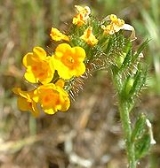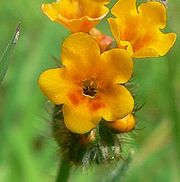
Fiddleneck
Encyclopedia

Flowering plant
The flowering plants , also known as Angiospermae or Magnoliophyta, are the most diverse group of land plants. Angiosperms are seed-producing plants like the gymnosperms and can be distinguished from the gymnosperms by a series of synapomorphies...
in the genus
Genus
In biology, a genus is a low-level taxonomic rank used in the biological classification of living and fossil organisms, which is an example of definition by genus and differentia...
Amsinckia. The name derives from the flower stems, bearing many small flowers, which curl over at the top in a manner reminiscent of the head of a fiddle
Fiddle
The term fiddle may refer to any bowed string musical instrument, most often the violin. It is also a colloquial term for the instrument used by players in all genres, including classical music...
. Fiddlenecks are in the family Boraginaceae
Boraginaceae
Boraginaceae, the Borage or Forget-me-not family, include a variety of shrubs, trees, and herbs, totaling about 2,000 species in 146 genera found worldwide.A number of familiar plants belong to this family....
, along with borage and forget-me-nots.
The fiddlenecks are native to western North America
North America
North America is a continent wholly within the Northern Hemisphere and almost wholly within the Western Hemisphere. It is also considered a northern subcontinent of the Americas...
and south-western South America
South America
South America is a continent situated in the Western Hemisphere, mostly in the Southern Hemisphere, with a relatively small portion in the Northern Hemisphere. The continent is also considered a subcontinent of the Americas. It is bordered on the west by the Pacific Ocean and on the north and east...
, but they have spread widely to other regions. They are annuals
Annual plant
An annual plant is a plant that usually germinates, flowers, and dies in a year or season. True annuals will only live longer than a year if they are prevented from setting seed...
, many of them bristly. Most have an erect stem, whose height varies from 20 to 120 cm. In most species the flowers are yellow, often with an orange tinge. Most are found at relatively low altitudes, below 500 metres.
The seeds and foliage of fiddlenecks are poisonous to livestock, particularly cattle
Cattle
Cattle are the most common type of large domesticated ungulates. They are a prominent modern member of the subfamily Bovinae, are the most widespread species of the genus Bos, and are most commonly classified collectively as Bos primigenius...
, because they contain alkaloid
Alkaloid
Alkaloids are a group of naturally occurring chemical compounds that contain mostly basic nitrogen atoms. This group also includes some related compounds with neutral and even weakly acidic properties. Also some synthetic compounds of similar structure are attributed to alkaloids...
s and high concentrations of nitrate
Nitrate
The nitrate ion is a polyatomic ion with the molecular formula NO and a molecular mass of 62.0049 g/mol. It is the conjugate base of nitric acid, consisting of one central nitrogen atom surrounded by three identically-bonded oxygen atoms in a trigonal planar arrangement. The nitrate ion carries a...
s. The sharp hairs of the plants can cause skin irritation in humans. However, the shoots, seeds or leaves of several species were used as food by Native Americans
Indigenous peoples of the Americas
The indigenous peoples of the Americas are the pre-Columbian inhabitants of North and South America, their descendants and other ethnic groups who are identified with those peoples. Indigenous peoples are known in Canada as Aboriginal peoples, and in the United States as Native Americans...
, and the plant also had some medicinal uses.
The species
Species
In biology, a species is one of the basic units of biological classification and a taxonomic rank. A species is often defined as a group of organisms capable of interbreeding and producing fertile offspring. While in many cases this definition is adequate, more precise or differing measures are...
are hard to distinguish, and their ranges overlap; furthermore several of them have large numbers of slightly different varieties, and several of the species hybridise naturally. To decide which species a particular specimen belongs to, therefore, is likely to require a detailed examination with an identification key in hand.
Species
- Amsinckia calycinaAmsinckia calycinaAmsinckia calycina, also known as hairy fiddleneck or yellow burweed, is a species of fiddleneck. It is native to Argentina and Chile and naturalised in Australia. It is an annual herb, growing to between 15 and 50 cm high and has pale yellow flowers. The species is poisonous to mammals....
, Hairy Fiddleneck or Yellow Burweed—Native to ArgentinaArgentinaArgentina , officially the Argentine Republic , is the second largest country in South America by land area, after Brazil. It is constituted as a federation of 23 provinces and an autonomous city, Buenos Aires...
and ChileChileChile ,officially the Republic of Chile , is a country in South America occupying a long, narrow coastal strip between the Andes mountains to the east and the Pacific Ocean to the west. It borders Peru to the north, Bolivia to the northeast, Argentina to the east, and the Drake Passage in the far...
. - Amsinckia carinata, Malheur Fiddleneck—Rare. Endemic to OregonOregonOregon is a state in the Pacific Northwest region of the United States. It is located on the Pacific coast, with Washington to the north, California to the south, Nevada on the southeast and Idaho to the east. The Columbia and Snake rivers delineate much of Oregon's northern and eastern...
and listed as endangered by the state. Has been considered to be a synonym of A. vernicosaAmsinckia vernicosaAmsinckia vernicosa is a species of fiddleneck known by the common name green fiddleneck. It is endemic to California, where it is an uncommon member of mountain, desert, and valley habitat in several regions. This is a hairy annual herb somewhat similar to other fiddlenecks, but waxy in texture...
, but this is implausible given the separation of their ranges. - Amsinckia douglasianaAmsinckia douglasianaAmsinckia douglasiana is an uncommon species of fiddleneck known by the common name Douglas' fiddleneck. It is endemic to the coastal Santa Monica Mountains and Santa Ynez Mountains of southern California.-Description:...
, Douglas' Fiddleneck—Uncommon. South Coast and Western Transverse Ranges of California - Amsinckia eastwoodiaeAmsinckia eastwoodiaeAmsinckia eastwoodiae is a species of fiddleneck known by the common name Eastwood's fiddleneck. It is endemic to California, where it grows in the varied plant habitat of the hills, mountains, valleys, and coastlines....
, Eastwood's Fiddleneck—Lower-lying areas of central and southern California, west of the Sierra Nevadas - Amsinckia grandifloraAmsinckia grandifloraAmsinckia grandiflora is a species of fiddleneck known by the common name large-flowered fiddleneck. This is a wildflower endemic to California and considered a Critically endangered species on the state and national level.-Distribution:...
, Large-flowered Fiddleneck—Central Valley of California. EndemicEndemic (ecology)Endemism is the ecological state of being unique to a defined geographic location, such as an island, nation or other defined zone, or habitat type; organisms that are indigenous to a place are not endemic to it if they are also found elsewhere. For example, all species of lemur are endemic to the...
to California and listed as endangered by the state and by the US federal government. - Amsinckia lunarisAmsinckia lunarisAmsinckia lunaris is an uncommon species of fiddleneck known by the common name bentflower fiddleneck. It is endemic to California, where it grows in the San Francisco Bay Area, the woods of the coastal and inland mountains just north, and the Central Valley and its San Joaquin Valley.Amsinckia...
, Bent-flowered Fiddleneck—Uncommon. San Francisco Bay AreaSan Francisco Bay AreaThe San Francisco Bay Area, commonly known as the Bay Area, is a populated region that surrounds the San Francisco and San Pablo estuaries in Northern California. The region encompasses metropolitan areas of San Francisco, Oakland, and San Jose, along with smaller urban and rural areas...
, Inner Coast Ranges and western Central Valley of California. Endemic to California and listed as fairly endangered by the state. - Amsinckia lycopsoidesAmsinckia lycopsoidesAmsinckia lycopsoides is a species of fiddleneck known by the common name tarweed fiddleneck. It is one of the more common species of fiddleneck. It is native to much of western North America from California to British Columbia. It can be found in a wide variety areas.-Description:Amsinckia...
, Tarweed Fiddleneck—Common. Found in all the Pacific coast states of the USA (though not east of the Sierra Nevadas in California), and into IdahoIdahoIdaho is a state in the Rocky Mountain area of the United States. The state's largest city and capital is Boise. Residents are called "Idahoans". Idaho was admitted to the Union on July 3, 1890, as the 43rd state....
to the east and British ColumbiaBritish ColumbiaBritish Columbia is the westernmost of Canada's provinces and is known for its natural beauty, as reflected in its Latin motto, Splendor sine occasu . Its name was chosen by Queen Victoria in 1858...
to the north - Amsinckia menziesiiAmsinckia menziesiiAmsinckia menziesii is a species of plant in the Boraginaceae family, the Borage or Forget-me-not family. It is the "common fiddleneck" and has two varieties:-References:***...
, Rancher's Fireweed—Abundant throughout the western states of the USA, in British Columbia and in Baja CaliforniaBaja CaliforniaBaja California officially Estado Libre y Soberano de Baja California is one of the 31 states which, with the Federal District, comprise the 32 Federal Entities of Mexico. It is both the northernmost and westernmost state of Mexico. Before becoming a state in 1953, the area was known as the North...
, at heights of up to 1700 metres. Also native to South America, and found as an alien species in eastern North America and the Old World. Several varieties recognised. - Amsinckia spectabilisAmsinckia spectabilisAmsinckia spectabilis is a species of fiddleneck known by the common names seaside fiddleneck and woolly breeches. It is native to the west coast of North America from British Columbia to Baja California, where it grows in sandy habitat, including direct coastline.Amsinckia spectabilis is is a...
, Seaside Fiddleneck or Woolly Breeches—Found on the Pacific coast of North America from British Columbia to Baja California, and on offshore islands, at heights of up to 300m. - Amsinckia tessellataAmsinckia tessellataAmsinckia tessellata is a species of fiddleneck known by the common names bristly fiddleneck and devil's lettuce. It is native to much of western North America from British Columbia to many California habitats, and to New Mexico, Sonora, and Baja California...
, Devil's Lettuce or Bristly Fiddleneck—Common. Found at heights up to 2200 metres, in most of California, Arizona, Oregon and Washington; also found in South America. Absent from the Sierra Nevadas and the north coastal regions of California. Several varieties recognised. - Amsinckia vernicosaAmsinckia vernicosaAmsinckia vernicosa is a species of fiddleneck known by the common name green fiddleneck. It is endemic to California, where it is an uncommon member of mountain, desert, and valley habitat in several regions. This is a hairy annual herb somewhat similar to other fiddlenecks, but waxy in texture...
, Green Fiddleneck—Uncommon. Found at heights of up to 1500 metres, in the south Coast Ranges of California and the Mojave DesertMojave DesertThe Mojave Desert occupies a significant portion of southeastern California and smaller parts of central California, southern Nevada, southwestern Utah and northwestern Arizona, in the United States...
.
External links
- Has Your Animal Eaten This Plant?
- Jepson Manual treatment of the genus
- http://elib.cs.berkeley.edu/cgi/img_query?where-genre=Plant&testing=123&rel-taxon=contains&where-taxon=Amsinckia&rel-namesoup=contains&where-namesoup=&where-lifeform=any&rel-location=like&where-location=&rel-country=eq&where-country=any&rel-state=eq&where-state=any&where-county=any&where-collectn=any&rel-photographer=eq&where-photographer=any&rel-kwid=equals&where-kwid=Pictures of fiddlenecks in the CalPhotos database]

